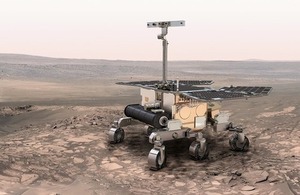
Life on Mars? - ExoMars Programme
Published By GOV.UK [English], Wed, Dec 15, 2021 11:26 AM
The ExoMars mission has been set up to address one of the biggest space science questions of our age – to understand whether life has existed elsewhere in the Universe.
The European Space Agency’s Exploration Programme established the ExoMars programme, consists of two missions for this purpose – in 2016 and 2022.
The missions will answer important questions about the Martian environment and develop technologies that will lay the foundations for human exploration beyond low Earth orbit. The missions are in collaboration with Roscosmos, the Russian Space Agency.
The main aims of ExoMars are to examine the geological environment on Mars and search for evidence of environments that may have once, and perhaps could still, support life.
It will also assist in preparing for other robotic missions, including a Mars Sample Return mission, and possible future human exploration. Data from the mission will also provide invaluable input for broader studies of martian geochemistry, environmental science and exobiology – the search for evidence of life on planets beyond Earth.
A mission in two parts
2016 mission into the Martian atmosphere
The 2016 mission concentrated on orbital science observations, particularly those of the methane in Mars’ atmosphere, first detected by ESA’s Mars Express mission in 2003.
The presence of methane in the martian atmosphere could suggest evidence for possible biological or geological activity.
This first mission arrived with two elements– the Trace Gas Orbiter (TGO) and an Entry, descent and landing Module, known as Schiaparelli. The TGO started scientific operations in April 2018.
The TGO carried four scientific instruments to detect and study atmospheric trace gases, such as methane.
ExoMars Trace Gas Orbiter analyses the martian atmosphere. Credit: ESA/ATG medialab
The UK was involved in the development and delivery of one of these instruments called NOMAD with Dr Manish Patel at the Open University.
Read about the results of this mission:
British instruments reveal secrets of Martian sky
Ice on Mars
Find out more about the 2016 ExoMars mission.
2022 mission onto the Martian surface
The 2020 rover named ‘Rosalind Franklin’, will be devoted to study geology, geochemistry and exobiology. It will search Mars’ surface for evidence of environments that may once have supported life, and may even still do so today.
As the first European rover to traverse the surface of Mars it will uniquely drill down to two metres into the martian surface allowing the Rosalind Franklin rover’s scientific instruments to sample and analyse the soil, determine its mineral content and composition, and search for evidence of whether past environments could once have harboured life.
The Rosalind Franklin will roam around the Martian surface by using electrical power generated from its solar arrays. It’s software will have a degree of ‘intelligence’ and autonomy to make certain decisions on the ground and will navigate using optical sensors. On arrival of the Rosalind Franklin in 2022, the orbiter will relay data from the rover back to Earth.
The UK is the second largest contributor to the ExoMars mission with a contribution of €287 million.
Key facts
the Rosalind Franklin rover due for launch in 2022 and will land on the Oxia Planum on Mars’ surface
the UK’s main involvement is the development of Rosalind Franklin vehicle, software and the design of the parachute sub-system. UK scientists are involved in two scientific instruments on the rover
the lead builder of Rosalind Franklin is UK Airbus Defense and Space
the Rover Operations Control Centre (ROCC) will be located in Turin, Italy and the mission control will be at the European Space Agency Operations Centre (ESOC) in Darmstadt, Germany
Roscosmos will provide a Proton launcher for both missions and the decent module for the 2022 mission
How is the UK involved?
The Rosalind Franklin rover was built by Airbus Defence and Space, at the company’s UK facility in Stevenage, UK.
The rover has been named after Rosalind Franklin, a UK scientist and co-discoverer of the structure of DNA. ExoMars is the first to honour a woman scientist on its flagship discovery craft.
SCISYS UK Ltd has been supporting the development of the Rosalind Franklin rover on-board software and its autonomous operations.
Rosalind Franklin rover will house a number of scientific instruments and there is considerable UK involvement from a number of academic institutions with the on-board rover mast fitted to ExoMars rover. Credit: Airbus–M.Alexander.
The panoramic camera (PanCam) system on the Rosalind Franklin rover is UK-led with scientists from University College London’s Mullard Space Science Laboratory (MSSL) working with the University of Aberystwyth, Birkbeck College and the University of Leicester. PanCam will provide imagery of Mars’ surface that will allow reconstruction by 3-D digital terrain mapping.
It will also provide context for drill sampling and rover instrumentation.
The wide-angle cameras will provide stereo information while the high-resolution camera will enable close-up images of martian structures and features.
Raman LIBS
The University of Leicester, Bradford University and STFC Rutherford Appleton Laboratory are key players in the development of the CCD camera on the Raman Laser Spectrometer (Raman LIBS),which can detect the presence of chemical compounds including minerals and also specific types of “biomarkers” – chemicals indicative of past or present life – that are produced by primitive micro-organisms to enable them to adapt to life in extreme environments.
Such organisms are well-known on Earth and probably represent the most likely form of life that could have existed on Mars.
Follow the latest news from ESA
Press release distributed by Media Pigeon on behalf of GOV.UK, on Dec 15, 2021. For more information subscribe and follow